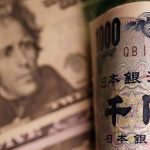
LONDON (Reuters) -The yen dropped against the dollar on Thursday, reversing direction after a sudden surge late on Wednesday that traders and analysts were quick to attribute to intervention by Japanese authorities.
The yen was 0.5% lower at 155.30 per dollar as of 0746 GMT, retracing about half of its late Wednesday surge from around 157.55 to exactly 153 over a period of about 30 minutes.
The sharp move on Wednesday came in a quiet period for markets after Wall Street had closed, and hours after the U.S. Federal Reserve had wrapped up its policy meeting.
The dollar was already on the back foot as Fed Chair Jerome Powell confirmed the central bank’s easing bias, even as he reiterated that sticky inflation meant interest rate cuts may be a while in coming.
“It caught markets off guard because, obviously, it happened in the U.S. session and seemed to be timed with the FOMC to take advantage of a weaker dollar,” said Kyle Rodda, senior financial market analyst at Capital.com in Melbourne.
“The ‘sneak attack’ element really is the MOF looking to punish speculators and send a warning about shorting the yen,’ he said, referring to the Japanese Ministry of Finance (MOF).
Japan’s vice finance minister for international affairs, Masato Kanda, who oversees currency policy at the MOF, told Reuters he had no comment on whether Japan had intervened in the market.
The dollar remains up more than 10% against the yen this year, as traders push back expectations on the timing of a first Fed rate cut, while the Bank of Japan has signalled it will go slow with further policy tightening after raising rates in March for the first time since 2007.
INTERVENTION?
The gap between long-term government bond yields in the two countries is 371 basis points. That helped lift the dollar to a 34-year peak of 160.245 yen on Monday and also spurred a sharp reversal, which official data suggested was because of Japanese intervention totalling about $35 billion.
“I don’t think intervention alone can cap dollar-yen,” said Niels Christensen, chief analyst at Nordea.
“The Bank of Japan continues to be reluctant to move the key rate higher, which is one reason why I expect the market to test the upside in dollar-yen.”
The MOF likely intervened in the currency market to signal they see 160 yen per dollar as their line in the sand, Columbia University academic and former finance ministry executive Takatoshi Ito told Reuters in an interview on Thursday.
The dollar index, which measures the currency against the yen, euro, sterling and three other major peers, was down 0.1% at 105.58 on Thursday, following a 0.6% retreat on Wednesday from near six-month highs.
The euro was up 0.1% $1.0727, after climbing 0.5% in the previous session.
Sterling gained 0.1% to $1.2544, adding to Wednesday’s 0.3% rise.
As widely expected, the Fed held rates steady on Wednesday and Powell stressed it “will take longer than previously expected” for policymakers to become comfortable that inflation will resume the decline towards their 2% target. At the same time, he characterized the risk of more hikes as “unlikely.”
“There was a collective sigh of relief in the financial markets after the Fed refrained from increasing its hawkishness,” said Jack Mclntyre, portfolio manager for global fixed income and related strategies at Brandywine Global.
“Think of this outlook as ‘high for longer’ as opposed to ‘higher for longer.’ The latter implies rate hikes, which is not today’s story.”
Hotter-than-forecast Swiss inflation in April drove the Swiss franc higher against both the euro and dollar.
“The probability of another cut (from the Swiss National Bank) in June is a little less likely but I think they will still be quite pleased with the inflation situation,” Nordea’s Christensen said.
“I would still expect another cut in June, especially if the European Central Bank also cuts rates next month.”
To read the full article, Click Here

